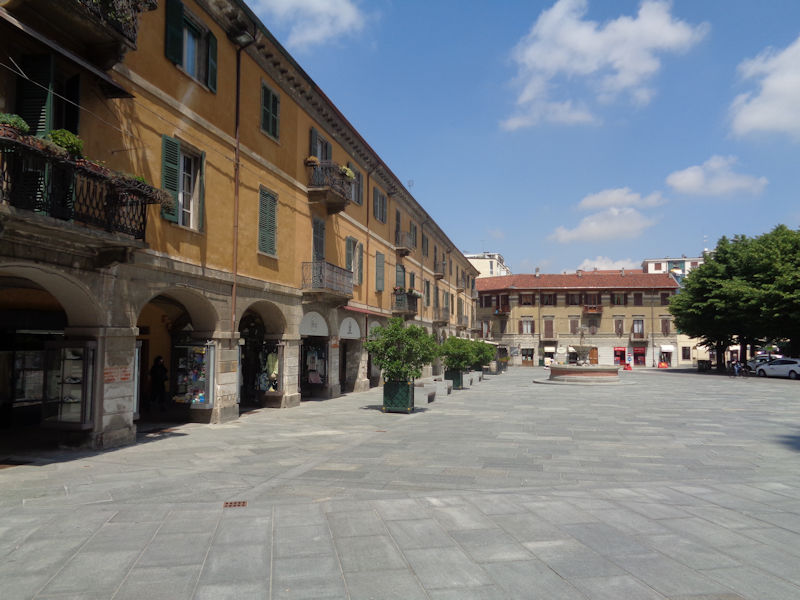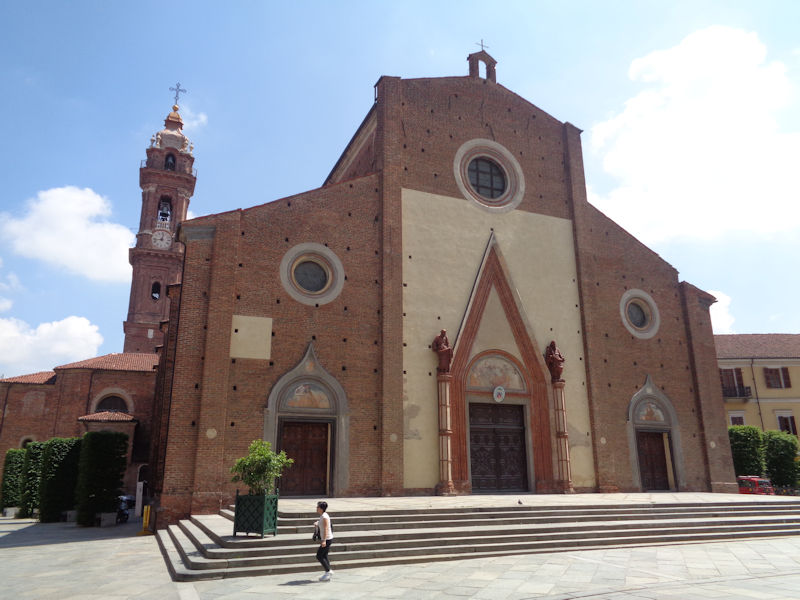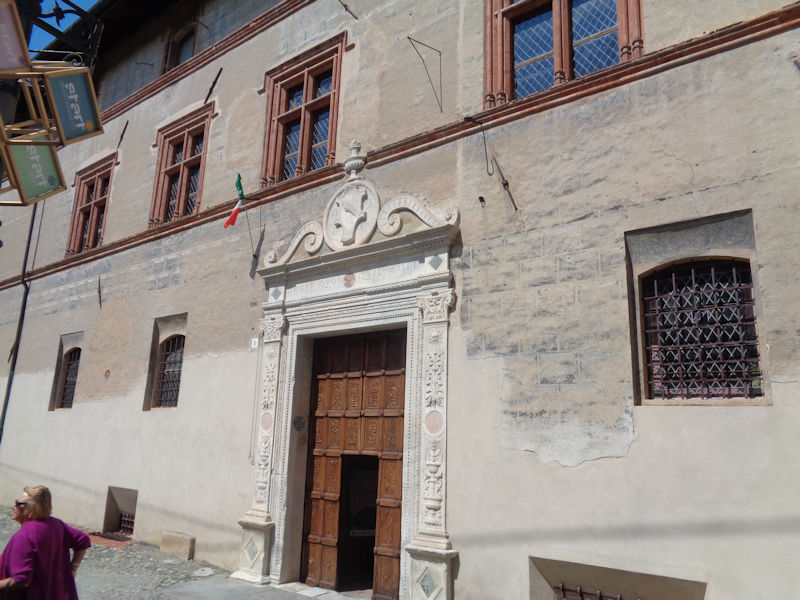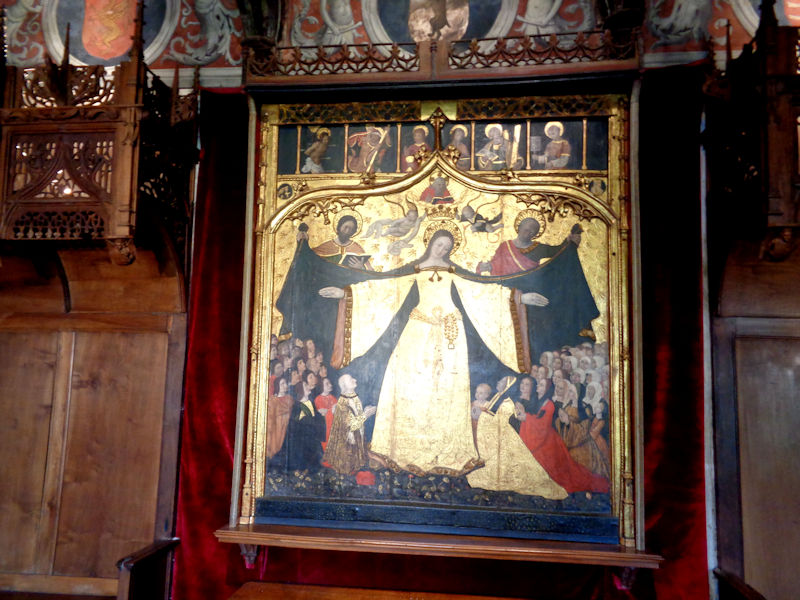You may not find this terribly rewarding unless you're included here, so this is a good time for casual and random browsers to turn back before they get too caught up in the sweep and majesty of the proceedings and can't let go.
18 May 2018

In beautiful downtown Saluzzo, we're parked in the Piazza Garibaldi and are progressing towards the old centre of town, trembling with anticipation. Present-day Saluzzo is a small city of about 17,000 citizens leaning up against the foothills of Monte Viso (Monviso, 3,841m) in the Cottian Alps along the present French-Italian frontier. It lies in the province of Cuneo in the Piemonte region, not far from the upper reaches of the river Po, about 50km southwest of Torino and the same distance northwest of the coastal city of Savona.

Part of the complex of the Duomo is on the left. Our particular fascination with Saluzzo derives from the fact that, throughout the Middle Ages, specifically from 1125 to 1548, it was the seat of the independent Marquisate of Saluzzo that was able for centuries to ride out the aggressive attentions of much larger neighbors, like Savoy, Monferrato, and Milan, as well as the French and the Holy Roman Empire.

The Fontana di Piazza Garibaldi

Along the Via Ludovico II facing the side of the Duomo. The Gallic tribes of the region were brought under the control of the Romans in about 125 BC. Following the Carolingians' 8th century intervention in northern Italy, Saluzzo became the seat of a count and, years later, it was part of the vast territories of the Aleramici dynasty of Franks who'd come to the region in the 9th century and by the 11th century were dominant from Monferrato down to the Med, with a branch even in Sicily. Several members of the clan were significant players in the Crusades, including one who was briefly King of Jerusalem.

The broad promenade of the Corso Italia

This is the Duomo di Saluzzo, the Cattedrale Maria Vergine Assunta, closed for lunch; we'll be back. The Aleramici were launching off branches of the family as
the years passed, and by the 11th century the del Vasto family of Savona had been predominant in the southern portions of the region for some generations. In 1084 Boniface del Vasto was made Margrave of Savona and Western Liguria and at some point had received the county of Saluzzo as a fief from the Margrave of Torino -- in 1125 he split Saluzzo off as a marquisate for his son (probably by a granddaughter of Henry I Capet, King of the Franks) Manfred I del Vasto, from whom it descended more or less intact for the next four centuries.

The spacious Corso Italia. We're planning first to visit the castle and its museum up the hill, and are presently walking in the wrong direction. All of this, including the Duomo, was outside the medieval double row of city walls.

The monument on the left is to a native son, Silvio Pellico, an early 19th century poet and playwright who was active in anti-Austrian revolutionary activities and spent ten years in Austria's Italian, Czech, and Slovenian prisons.

In the absence of prominent directions to the hilltop castle, we're lost . . .

. . . so when in doubt, go up. (The normal itinerary to the castle and old city begins at the other side of the Duomo.)

A warren of cobbled streets, the Via Gualtieri, leading uphill

And providentially, to the Piazza Mondagli, with the public library and Silvio Pellico's birthplace -- we've rejoined the tourist itinerary to the castle.

And lost it again, immediately, but we're still proceeding uphill.

Et voilà, the Salita al Castello . . .

. . . and city centre, within the double walls (now long gone), back in the day, populated by mostly 14th century commercial and civic buildings. The castle awaits us.

Sadly, the famous 48m-high Civic Tower of Saluzzo, built in 1462, is out of sight on the top of the pink Palazzo Comunale on the right -- we never noticed it, but were rudely turned away the street-level door to it anyway.

The tower of the Duomo framed by the Salita al Castello

The Castiglia di Saluzzo, first built by the Marquis Tomasso I between 1271 and 1286, along with the first city walls. It was originally equipped with four towers, a moat and a drawbridge, but during a period of relative political calm in the region, the Marquis Tommaso III in the late 14th century streamlined things a bit to convert the place into a more comfortable residential palace.

Subsequently, the Marquis Ludovico II renovated it still further, in 1492, for the arrival of his second wife Margherita di Foix-Candale, adding a nice garden and this round tower.

The fountain called La Drancia, built in 1481. The castle's closed for lunch, and so we'll take the hint and adjourn for a restorative bite to eat.

We're back.

The castle was the residence of Saluzzo's Marquesses for over four centuries, until in 1548 the city and its territories were overrun by the French and held as a fief of the crown of France, but in 1588 the aggressive Duke of Savoy, Charles Emmanuel I, took advantage of the French Wars of Religion then in progress and seized Saluzzo for himself. This was formalized in 1601 when France exchanged Saluzzo for the Savoyard region of Bresse north of Lyon.

Saluzzo's Golden Boy, or one of them -- this is a copy of the monument of Ludovico II (1434-1504), the Marquis (from 1475) and soldier (usually on the French side during the late century Italian Wars) towards the end of Saluzzo's golden age, in the San Giovanni church down the street.

Eleven rooms of the castle are adorned with the Museum of Chivalric Society, dedicated to the courtly society of Saluzzo in a wider European context.

The room of the Saluzzo women -- none of whom seems terribly noteworthy, except for Alice (Alesia) of Saluzzo (d. 1292), daughter of the 4th Marquis, Tommaso I, who married Richard Fitzalan, the 8th Earl of Arundel in England and became Countess of Arundel after 1289. She was the second Italian woman to marry into the English nobility, preceded only by her aunt Alasia who married the de Lacy Baron of Pontefract in 1247.

One of the more interesting of the Saluzzo forebearers was the Marquis Tomasso III (1356-1416), a cultured gentleman who usually managed to evade the persistent threats from Savoy, and who, apparently whilst imprisoned by the Savoyards for two years in Savigliano and Torino awaiting his ransom, wrote a semiautobiographical poem about adventures in knightly chivalry, Le Chevalier Errant, that's considered a seminal text on chivalric values. The book inspired the brilliant frescoes in the Baronial Hall of the family's Castello della Manta (which we will visit later today).

Period illustrations for the strange story of the Patient Griselda, set in Saluzzo, a peasant girl who was compulsively tormented by her awful husband, 'Gualtieri' (Walter) Marquess of Saluzzo, to test her obedience and unconditional loyalty to his wishes. Decades later he informed her that she had passed the tests, returned her stolen now-grown children to her, promised to be nice from then on, and she said 'thanks ever so much' so they lived happily for whatever time was left. The moral of the story is completely opaque. The tale was widespread but the most influential version occurs on Day Ten in Boccaccio's Decameron (ca.1352), was picked up by Petrarch and by Chaucer (The Clerk's Tale in the Canterbury Tales) a few years later, and, inter alia, appeared in four 18th century operas.

From the early 19th century until 1992, the castle was used as a prison, and a grim prison it must have been. Now the basement section of the castle is preserved as the Museo della Memoria Carceraria, or Museum of Memory of Prisons, with displays of this prison in its past as well as educational panels and displays on the history of prison treatment generally and of the phenomenon of mass incarceration.

In terms of the growth of the mass incarceration of populations, the USA and Britain don't come off very well unfortunately.

But at least we can still say 'We're Number One'.

It definitely puts you off your lunch.

Time for a change of tourist attractions

So on a lighter note, we're back out onto the Salita al Castello, ready for the next adventure. The 15th century Civic Tower is directly above Kristin, on the left in this photo, but we never looked up.

But, in any case, the 15th century City Hall and former Jesuit college were, we were told, closed.

Saluzzo street scene

There's our alley, the Via San Giovanni

Saluzzo alley scene

The Chiesa di San Giovanni is a fascinating church that was begun in the 13th century and enlarged by the Dominicans in a Gothic style beginning in 1330, and was only completed in 1504. The square belltower, with five rows of mullioned windows and an octagonal spire, dates from a remodeling project in 1376.

The façade of the Church of St John the Baptist also dates from the 1376 remodeling, but the fresco of St Christopher has been shown to be a forgery from 1929, apparently.

The nave with two aisles with cross vaults, enclosing a number of side chapels, seen from the front portal at the top of a flight of stairs leading down into the interior. The gilded wooden tabernacle at the high altar in the apse is dated to 1610.

There are some 19th century 'restoration' decorations around but a good number of original frescoes as well.

Not all of the surviving frescoes are in pristine condition.


A black Madonna and Child

A modern Madonna under an interesting baldachin

Any number of Marquesses of Saluzzo are interred in this funerary chapel, including . . .

. . . Ludovico II, who's distinguished by his earnest but undistinguished military career but also by having engineered the Monte Viso Tunnel (the Buco di Viso), a 75m long pedestrian tunnel through impassable mountain heights at nearly 2,900m altitude, opened in 1479 and possibly the oldest such tunnel in Europe. Its purpose was to create a trade route through to Provençe without having to pass through the territories of the perennial enemies of Savoy. It also permitted Ludovico himself to escape to France in 1486 when his castle was under Savoyard pressure, and it's said that the French kings Charles VIII in 1494, Louis XII in 1499, and François I in 1525 came through the tunnel in their invasions of northern Italy. The tunnel's no longer in use but was reopened again for fun in 2014.

The Renaissance sepulchre of Marquis Ludovico II in Paesana white marble, c. 1508 -- a niche was left for his wife, but she vacated the territory after the coup of her wayward second son in 1528 and was eventually buried in France in 1536.

Looking from the altar to the stairs at the far end leading up to the street outside

Out into the cloister


The belltower seen from the cloister

Just 150m along the Via San Giovanni, we come to the third of Saluzzo's four premier attractions, the Civic Museum in the Casa Cavassa, a Renaissance-era residence of father and son Galeazzo and Francesco Cavasso from Carmagnola, prominent officials in the court of Ludovico II and of his widow during her regency.

The façade of the Casa Cavassa, retaining some medieval traces of the earlier building that was thoroughly remodeled by the Cavassas in the early 16th century. The door is by Matteo Sanmicheli, 1518-1528.

The L-shaped loggia and open courtyard of the Casa Cavassa

The present building, built on sloping ground, comprises six floors, three of them partially underground for services, storage, and servants, with the reception halls and family rooms above.

One of our docents is awaiting us on an upper floor, as we await the ticketseller getting off her cellphone to sell some tickets.

The condition of surviving frescoes is remarkable, considering: after the death of Ludovico II's first son Michele Antonio, who'd been pro-French like his predecessors, his successor Gian Ludovico (who'd been imprisoned by his mother for his pro-imperial, anti-French tendencies) became Marquis in 1528 and Francesco Cavassa's influence and life came to an end. (The French King François I deposed Gian Ludovico in 1529.) The Cavassa family retained the house long past their glory days, into the 18th century, but eventually it was divided up into flats and continued its deterioration over time.

In 1883 the place was bought by a diplomat and antique lover, the nephew of the statesman Massimo Tapparelli, Marquis of Azeglio, who brought in experts to restore it to its Renaissance appearance. He scoured the markets to replace the furnishings and artworks that had been looted with the fall of Francesco in 1528, and commissioned new pieces that reproduced the look of the late Gothic and Renaissance styles. This is the 'De Foix' room, referring to Ludovico II's widow and regent for his successor, Margherita di Foix-Candale.

The city inherited the house after Tapparelli d'Azeglio's death in 1890 and opened it to the public soon after, and additional significant works of art have been added to the collection over time. The coats of arms atop the walls represent the local families ennobled by Ludovico I in 1460.

The most impressive piece in the collection is this altarpiece of the Madonna della Misericordia by Hans Clemer (c.1500), a Flemish/French painter active in the valleys of the Saluzzo marquisate.

A humorless churchy sort of picture, with happily a bit of fun in the lower right corner . . .


The view over Saluzzo town from the Casa Cavassa

The Chiesa di San Giovanni just up the street, with its belltower (left) and the Civic Tower over the Palazzo Comunale on the right.

The L-shaped layout of the Casa Cavassa, with a spiral staircase in the right-centre

A period bed with skis

Portraits of Carlo Emanuele I, Duke of Savoy, who occupied the Marquisate of Saluzzo in the fall of 1588, when it was under French protection, and received it officially in 1601 in an exchange of territories with France, and of his wife, known as the Infanta Catherine Michelle of Austria (or of Spain), who was a daughter of Philip II, King of Spain, and sister of Isabella Clara Eugenia, later the Governor of the Spanish Netherlands, and who served as the Regent of Savoy during her husband's absences. The portraits are by Giovanni Carraca, ca. 1585, and were brought here from Lagnasco Castle (which we will be visiting tomorrow).

A last look round the Casa Cavassa

Back down the hill to ground level

The Corso Italia and, eventually . . .

. . . back to the Duomo, the Cattedrale Maria Vergine Assunta, built on the site of a predecessor church to Santa Maria just outside the Santa Maria gate in the city walls between 1491 and 1501, and recognized by Pope Julius II as the seat of the diocese of Saluzzo in 1511. The statues flanking above the central door evidently represent Saints Peter and Paul, and the lunette holds a picture of the Assumption of the Virgin. The belltower dates from 1771 and the broad steps in front of the three portals were added in 1842.

The wooden cross suspended above the high altar is attributed to Baldino di Surso, a late 15th century wood sculptor from Pavia, and there are seven secondary altars in each of the side aisles.

An early 16th century terracotta group showing the Deposition


At the high altar, there are a number of wooden figures (Assumption of the Virgin supported by angels) by the early 18th century artist Carlo Giuseppe Plura, with two early martyrs from the region flanking them and waving flags: one is the patron saint of Saluzzo, St Chiaffredo, and the other St Constantius, both of whom were reputedly Roman soldiers who escaped the martyrdom of the entire Christian 'Theban Legion' at Agaunum (St-Maurice, Switzerland) in AD 286.


This completes our whirlwind tour of old Saluzzo, following which we progressed to the Saluzzo family's castle of Manta, some photos of which are shown on the preceding page.
Next: Some more castles in the Langhe area

 Dwight Peck's personal website
Dwight Peck's personal website












































































